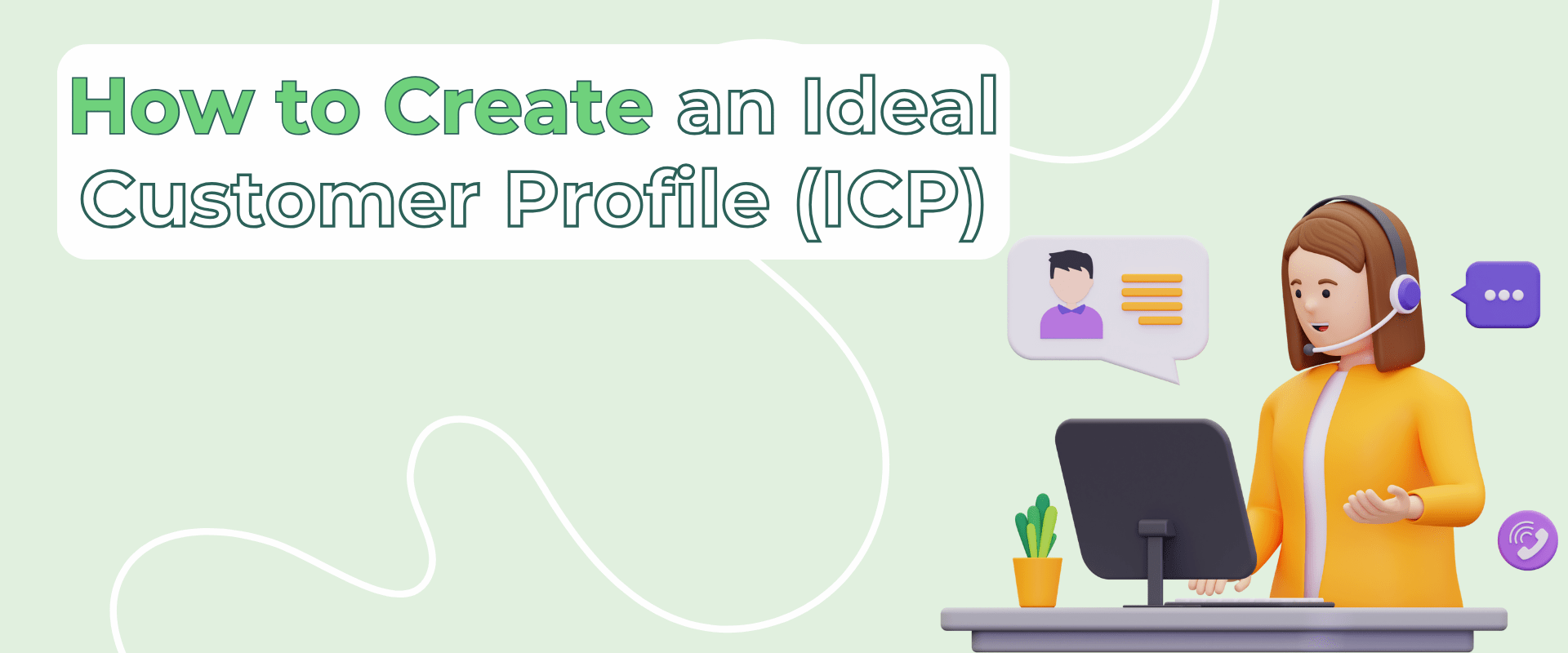
How to Create an Ideal Customer Profile (ICP)
Have you ever wondered who the ideal customer is for your business? Imagine you had the opportunity to create the perfect audience for your product or service. What would they look like? What do they appreciate? What problems do they experience?
In this blog post, we’ll look at how to create an ideal customer profile (ICP) and why it’s crucial to your marketing strategy.
What is an ideal customer profile (ICP)?
The Ideal Customer Profile (ICP) is a kind of “picture of the ideal customer” for your business. It is not just an abstract description of your target audience. It’s a blueprint that helps you better understand exactly who your ideal customer is, what motivates them, and how they interact with your product or service.
It’s a detailed portrait that includes their goals, fears, concerns, hobbies, and even their behaviors on the internet. For example, you might imagine that you’re writing a real-life novel about your ideal customer. And you want to know everything about them to create the most compelling and appealing image possible. Creating an ICP allows you to focus your marketing efforts, make sure you’re appealing to the right audience, and even develop products or services that perfectly fit their needs.
To create an effective ICP, you need to make an in-depth analysis of your target audience, including researching their behavior, reactions to previous marketing campaigns, their preferences, and general trends in their industry. This allows you to create not just an “ideal customer” but a real, live person that you can engage with through your marketing efforts.
The ideal customer profile (ICP) template.
Creating an Ideal Customer Profile (ICP) often involves using a template to help organize information about your target audience. Now let’s dive into the components of the ICP template and look at how each aspect contributes to creating a vivid picture of your ideal client.
Demographics:
- Age: Identify the age groups most likely to be interested in your product or service.
- Gender: Explore whether there are differences in needs and preferences between the male and female segments of your target audience.
- Geographic location: Identify where your potential customers are located to better adapt your marketing strategy to their location.
- Education: Explore the education level of your target audience and how it affects their needs and decision-making.
Behavior Characteristics:
- Needs and wants: Explore what needs your audience has that your product or service can solve.
- Problems faced: Identify the key problems your target audience faces and how your product can solve them.
- Content consumption preferences: Study what type of content your target audience prefers (articles, video, audio, etc.).
- Buying habits: Analyze how your target audience makes buying decisions, where they buy, and what influences their decision.
Professional Data:
- Profession: Study the industry your customers work in, their role in the company, their main challenges and problems.
- Position: Identify who in the organization makes buying decisions and what factors they consider when making a decision.
- Company size (for B2B): Figure out the company size that is most appropriate for your product or service.
Technological characteristics:
- Technology used: Research what technology your target audience uses in their daily work or life.
- Preferred online platforms: Understand the online platforms where your target audience spends most of their time to better customize your digital strategy.
By carefully developing an ICP, you will build the foundation for more accurate targeting, increased customer satisfaction, and ultimately, business success. Leveraging the power of ICPs will allow you to turn fuzzy marketing efforts into personalized experiences. It will resonate deeply with the people who matter most to your business.
Why should an ICP be part of marketing strategy?
Incorporating an Ideal Customer Profile (ICP) into your marketing strategy is necessary for several compelling reasons:
Exact targeting
The ICP allows companies to accurately identify and understand their most valuable customer segments. This allows for targeted and personalized marketing activities. By focusing on the specific needs and preferences of these ideal customers, companies can optimize their marketing spend and resources for maximum impact.
Customized Product Development
With a well-defined ICP, companies can adapt their products and services to the needs of their ideal customers. This customer-centric attitude improves product relevance and increases the chances of customer satisfaction and loyalty.
Effective Communication
Understanding the nuanced behaviors, challenges and ambitions of the ideal customer allows companies to create compelling and resonating messages. By appealing directly to the desires of their ideal customers, companies can establish a more emotional connection, helping to strengthen relationships and brand affection.
Improving customer attraction and retention
By identifying the characteristics of their ideal customer, companies can improve their customer engagement strategies to attract those who exactly fit that profile. Moreover, a well-designed ICP also helps retain existing customers by continuously meeting their changing needs and expectations.
Optimized resource distribution
Incorporating ICPs into the marketing strategy helps companies distribute resources more efficiently. By focusing on targeting the most profitable customer segments, companies can optimize their marketing, sales and customer service resources to maximize return on investment.
In essence, ICP serves as a guiding light, directing businesses to more effective and efficient marketing efforts that resonate deeply with their most valuable customers, ensuring consistent business growth and success.
SalesNash used ICP methodology to define the target audience, resulting in a 30% increase in conversions over the last quarter. This emphasizes the importance of properly defining the ideal customer profile to achieve business success.
Difference between an ideal customer profile and a buyer persona.
The Ideal Customer Profile (ICP) and the buyer differ in their focus and scope in marketing and sales.
Ideal Customer Profile (ICP):
- Focus: The ICP is a broad description of the type of company or customer that is best suited for a business.
- Scope: Covers the characteristics of the full company or customer, including demographics, firm characteristics, problems, and needs.
- Goal: Helps businesses find the right companies or customers for their B2B sales and marketing efforts.
Buyer Persona:
- Focus: A buyer persona is a detailed representation of a person making a buying decision in target companies or accounts.
- Scope: It explores the personality, behavior, preferences, and pain points of a specific person involved in the buying process.
- Purpose: It helps customize marketing messages and sales strategies to match the needs and motivations of a specific buyer.
Key Differences:
- ICP focuses on finding the right companies or accounts, while Buyer Persona focuses on understanding the specific people making buying decisions with those companies.
- ICP is more focused on company fit, while Buyer Persona is more focused on understanding the individual buyer’s personal motivations and challenges.
Thus, ICP helps companies select the right companies, while buyer persona helps companies adapt marketing and sales efforts to reach out to individual buyers in those companies.
10 Steps to create your own ideal customer profile for B2B.
Creating an Ideal Customer Profile (ICP) for B2B involves several critical steps to ensure a complete and accurate representation of your target customer. Here are 10 essential steps for creating your own ICP for B2B:
- Gather data on current customers: Gather and analyze data on your existing customer base, including firm data, buying behavior, and interaction history. This will form the basis for identifying general traits of your most valuable customers.
- Do market research: Study the broad market to identify industries, verticals or segments that fit your value proposition and have a clear need for your products or services.
- Identify target industries: Narrow down the industries that best fit your business goals and experience. Consider factors such as market size, growth potential and relevance to your offerings.
- Define decision makers and influencers: Also, define the key decision makers and influencers in your target organizations. Understand their roles, challenges and priorities in the decision-making process.
- Create a buyer’s journey map: Describe the typical buyer’s journey and decision-making process in target organizations. Outline pain points, motivations, and criteria for evaluating decisions.
- Create detailed buyer personas: Develop detailed buyer personas that represent the roles and responsibilities of the people involved in the buying process. This includes understanding their professional goals, objectives, and preferences.
- Analyze customer behavior: Analyze how your target customers interact with your marketing channels, point of sale, and product offerings to gain insight into their preferences and needs.
- Request feedback from your sales and customer service teams: Take advantage of the opinions of sales and customer service staff who interact directly with customers. Their feedback can provide invaluable information about customer pain points and success criteria.
- Approve and improve the ICP: Regularly review and refine the ICP based on market changes, customer feedback, and the effectiveness of your sales and marketing strategies. Flexibility is key to maintaining an accurate ICP.
- Document and share the ICP: Summarize your findings into a formal document that describes the key attributes of your ideal customer. Make sure this document is widely shared and understood throughout your organization to align efforts and strategies.
! By following these 10 steps, companies will be able to create a solid ideal customer profile customized for the B2B marketplace, allowing for more effective targeting, personalized messaging, and improved customer engagement and retention strategies.

I have a profile of my ideal client. What’s next?
After you’ve built a portrait of your ideal customer profile, there are several strategic actions you can take to effectively use this valuable information. Here’s what you can do next:
- Customize your marketing efforts: Use the characteristics and preferences described in your ideal customer profile to adapt your marketing messages, content, and campaigns. This ensures that your marketing efforts will resonate more effectively with your target audience.
- Identify new prospective customers: Use your ideal customer profile as a reference point to identify new prospects and leads. This will help you prioritize those who are most likely to benefit from your offerings and become long-term, valuable customers.
- Measure and adjust: Continually track the effectiveness of your marketing, sales and customer engagement initiatives against your ideal customer profile. Use this data to correct and refine your strategies.
- Seek feedback: Engage with existing customers who largely fit the ideal customer profile to get feedback. This can provide valuable insights to further improve your products, services and customer experience.
A final word
In conclusion, we want to emphasize that creating an ideal customer profile is not just a strategic exercise, but a key element of a successful marketing strategy. Understanding the needs, preferences and characteristics of your ideal customer enriches your interactions with them, strengthens relationships and contributes to the long-term success of your business. Let this process help you more accurately target your most valuable customers, and make your business even more attractive and competitive as a result. Get in touch with us to find out more.
